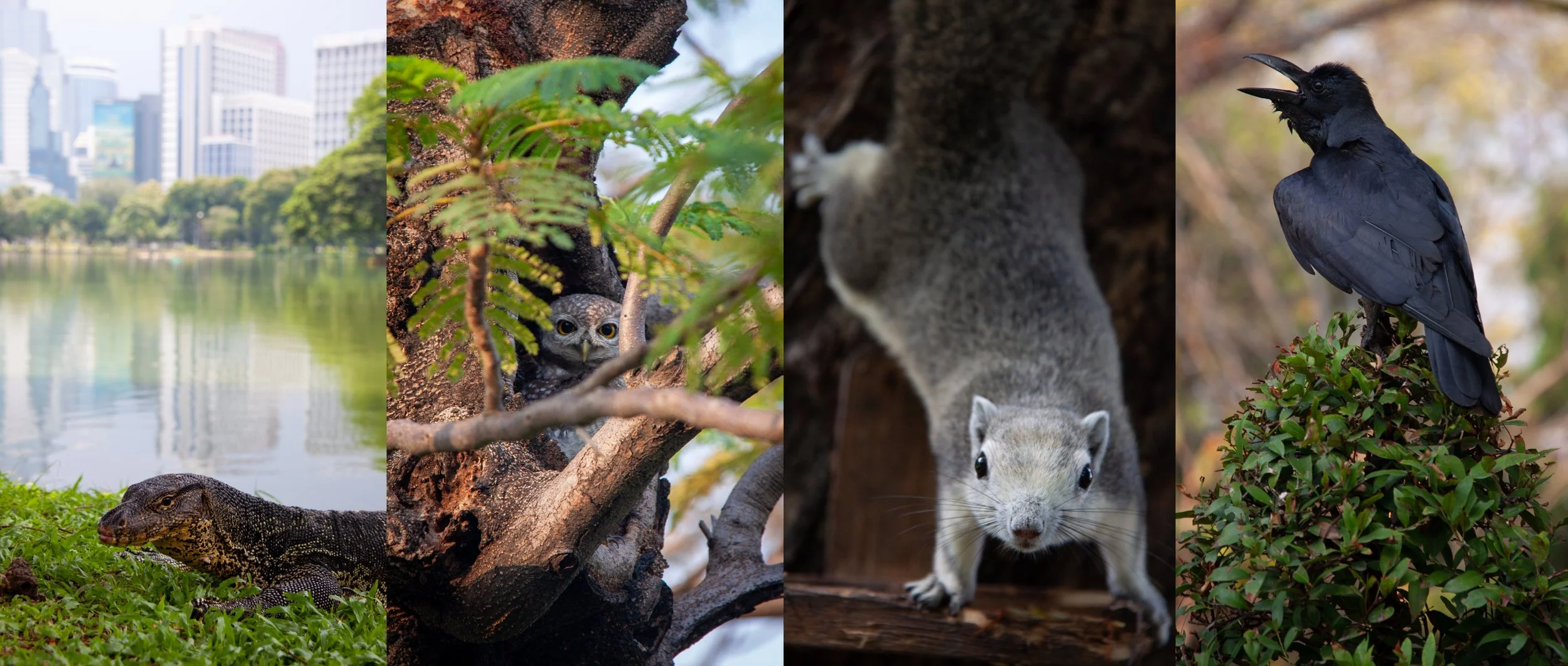Coppersmith Barbet
Psilopogon haemacephalus
The coppersmith barbet — a small bird about 16 cm (~6 in) long — often falls victim to bullying by other birds. Blue-throated barbets have been observed evicting coppersmiths from nesting holes, while red-vented bulbuls steal berries from male coppersmiths that are trying to feed their mates.
Parks of Bangkok
In my time in Bangkok, I've visited many of the city's wonderfully varied parks. There is Lumphini Park, with its giant water monitors that float through the waterways, sunbathe on the grass, and enact primaeval battles; Benchakitti Park, featuring lush wetlands buzzing with multicoloured dragonflies, like hovering jewels, and a proliferation of birds, from storks to orioles to owlets; Chatuchak Park is overrun by some of the worlds most curious squirrels, who have a love for playing peek-a-boo around tree trunks; and Romaneenart, a prison turned park, now run by gangs of thuggish, but still charming, large-billed crows.
Every park has its own set of residents and unique character — the quiet tranquillity of Benchakitti is far from the intensity of Lumphini, where crowds gather and gasp at the spectacle of a dragon duel. But, whichever park you visit in Bangkok, there's an almost ever-present sound that you're likely to hear; a beeping noise so consistent that, at first, I thought there existed some city-wide alarm system which was always low on battery. One day, while I browsed through common Bangkok birds on eBird, I pressed "Listen" on the coppersmith barbets page and my little "beeping mystery" was solved.
The Beeping Barbet
The coppersmith is visually dazzling, but it's also quite small — only around 16 cm (6.3 in) long — and often hidden. As such, it is easy to miss. Its presence, however, is obvious from an electronic-sounding "tuk" call, performed in so regular a rhythm that it tricked me into thinking it actually was electronic. When I eventually learned the source of the sound, I went back to the park with my eyes tuned to spotting the barbet. And, on my first try (in Queen Sirikit Park, adjacent to Chatuchak Park), I succeeded by essentially playing "hot or cold" with its beeps.
It was smaller than I'd expected. Its bulbous head looked nearly as big as its entire squat body — with a stubby tail that didn't contribute much extra length. Most of its plumage, its back and belly and wings, was green like a leaf. But its face was extravagantly painted in splashes and dabs of red and yellow, contrasted on black, as if it was an actor in a Kathakali dance.¹ Around its short, heavy bill sprouted copious wire-like whiskers.² It clung, straight-backed, to the top of an exposed branch, then shot off like an arrow in flight, disappearing with a receding "tuk".
Little Bird in a Big City
The coppersmith is the most commonly spotted barbet; perhaps because it prefers an urban lifestyle. It likes more open woodlands and parks, rather than dense forests, and often perches exposed at the tops of tree canopies to bathe in the dawning sunlight. Its nest and roost is a snug cavity in a tree limb, one which is hollow inside but still sturdy enough not to topple. Such cavities usually occur incidentally — perhaps when a limb breaks off and its stub decays, maybe caused by lightning or fire, industrious termites or a fungal infection. Large cavities are found in large, old trees, typically those between 100 to 150 years or older. Sometimes a dedicated female coppersmith can excavate a hollow herself, usually beginning some 3 months prior to her breeding season, but she can't just pick any tree —the wood must be soft or dead to allow for excavation. As a result, cavities are often limited and competition for real estate can be fierce.
The coppersmith barbet often loses out. Its larger relative, the blue-throated barbet, has been seen evicting the coppersmith from nesting holes — dragging it out by the back of its neck as it futilely tries to fight back. Other birds bully the barbet for its lunch. When breeding, a coppersmith shares its cavity nest with its partner, and the male brings the female food (figs, berries, insects, and flower petals). Red-vented bulbuls — drab, brown-black birds with red rumps — are known to wait around for a male coppersmith carrying forage back to his nest. The bulbul descends on the barbet and steals his berries, making him go back to his partner empty-beaked.
Bountiful Barbets
We've already met the coppersmith barbet's abusive cousin, the blue-throated barbet, but the family is quite a bit larger. The barbets belong to a bird order called Piciformes; related, unsurprisingly given their nesting habits, to woodpeckers and toucans (which are both cavity nesters). Barbets themselves are separated into four discreet families — the toucan-barbets, New World barbets, African barbets, and Asian barbets — all in all, comprising almost 100 species. The coppersmith belongs to the latter, Asian family.
The Megalaimidae family, or Asian barbets, include around 35 species of small, colourful, forest-dwelling birds. Most of them have bodies in various gradients of green plumage, like verdant jungle foliage. It's really their faces, or rather, their facial "make-up" that distinguishes them. Some, like the lineated barbet, have a plain face but display naked patches of bright yellow skin around their eyes like spectacles. The great barbet — the largest of all barbets, near the size of a pigeon — just wears a hood of dark blue over its entire head, accentuating its yellow, frowning bill. Others display shocks of bright colours, like the red face of the Malabar barbet or the blue face of the golden-naped barbet.
The face of a fire-tufted barbet looks to have been painted by a masterful make-up artist; with confident lines of black and white, ashy-grey blush, dapper green eyebrows and yellow collar, orange hair highlights and a characteristic fiery tuft — even its bill is decorated with blotches of black. At the other end of the style spectrum is the green-eared barbet. Rather than adorned by an artist, it looks to have grown from a seed; coloured in all greens and light woody browns, with its wing feathers like leaves, its belly and face plumes sprouting like moss.
Not all barbets are flashy. The sooty and brown barbets are coloured like earth and rust, with light underbellies and heavy dark bills. Several species, however, appear to have gone overboard with the face paint. From the red-throated to the red-crowned, the black-browed, Bornean and Taiwanese, these barbets show off an assorted patchwork of tie-dye colours on their faces — looking like little beaked clowns as they poke their heads out of their tree-hollow-homes.
Bangkok Barbet
The parks of Bangkok, I think, are one of the city's most admirable features, each offering its own attraction. I visit Benchakitti to be surrounded by bountiful life and for a calming stroll around its lake, Lumpini to gaze in awe at real-life dragons, Romaneenart to watch crows get up to mischief, and Chatuchak to play hide and seek with squirrels. But, wherever I go, I can be fairly certain that, even if I can't see it, I'll hear the rhythmic clicks of the coppersmith, and know I'm in the company of this lively little barbet. If you get the chance to visit Bangkok, I'd definitely recommend a day or two at a park, to walk among the playful squirrels and the roguish crows, the quarrelsome dragons and the beeping barbets.
¹ Kathakali is a traditional Indian performance that blends dance and play — usually adapting stories from Indian epics. It is performed by the Malayali people from Kerala, a state on the southwestern coast of the country, and involves intricate flowing costumes and colourfully painted masks.
² The barbets get their name from these stiff bristles, which encircle their hefty beaks. Just like a cat uses its whiskers to sense its environment through touch, the barbets' 'rictal bristles' — named such because they are located at the rictus (the gape of a bird’s mouth) — are likely used for a similar purpose.
Where Does It Live?
⛰️ Sparse woodlands, forest edges, parks and gardens.
📍 South and Southeast Asia; from India through to Indonesia and the Philippines.
‘Least Concern’ as of 12 June, 2024.
-
Size // Small
Wingspan // N/A
Length // 15 - 17 cm (5.9 - 6.7 in)
Weight // 30 - 52.6 g (1 - 1.8 oz)
-
Activity: Diurnal ☀️
Lifestyle: Social 👥
Lifespan: N/A
Diet: Herbivore (mostly fruits + some insects)
Favorite Food: Fruits 🍈
-
Class: Aves
Order: Piciformes
Family: Megalaimidae
Genus: Psilopogon
Species: P. haemacephalus
-
Given its small size, the coppersmith barbet is easily overlooked — but you'll know it's nearby by listening for an electronic-sounding "tuk" call, performed in so regular a rhythm it might almost convince you it actually is electronic.
A typical male coppersmith has a painted face of black, yellow, and red. Some forgo the yellow for fiery faces of only red-on-black. Females are usually duller than males, with less red on the face, while juveniles lack all red and sport faintly streaked throats.
The coppersmith is the most commonly seen barbet — likely because it prefers open woodlands, parks, and gardens, and often lives in urban areas.
It can be seen perching on a high branch, above the tree canopy, bathing in the dawning sunlight.
The barbet is a cavity nester; making its home inside cavities in tree limbs.
Tree hollows naturally form in older trees (100 to 150 years or older), but a dedicated female coppersmith can excavate a hollow herself — beginning some 3 months prior to her breeding season — but the wood must be dead or soft enough for proper excavation.
The coppersmith is often evicted from its hard-earned hollow by its bullying relative, the blue-throated barbet, which drags out the smaller coppersmith by the back of its neck.
During the breeding season, a coppersmith cavity is shared by a mated pair — with the male usually bringing food back to his partner and chicks.
Red-vented bulbuls are known to steal food from male barbets flying back home to feed their families.
The diet of a coppersmith is mostly frugivorous; consisting of berries, drupes, wild figs, mangoes, guavas, as well as seeds and the occasional insect caught mid-flight.
The barbets belong to the order Piciformes, along with woodpeckers and toucans (which are also cavity nesters).
There are almost 100 barbet species split into four families, but the coppersmith belongs to the Asian barbets (family Megalaimidae), with 35 species — a few of its relatives include the great barbet, fire-tufted barbet, green-eared barbet, and red-crowned barbet.
-
The journal of the Bombay Natural History Society (BHL)
iNaturalist - Asian barbets
Ornithology - rictal bristles
Keralatourism.org - kathakali
-
Cover Photo (John Russell / Macaulay Library)
Text Photo #01 (My own photos taken around Bangkok)
Text Photo #02 (Uday Agashe / iNaturalist)
Text Photo #03 (Andika Darmawan / iNaturalist)
Text Photo #04 (Rajkumar Das, Hemant Kirola, and Matthew Kwan / Macaulay Library)
Text Photo #05 (David Irving, Natthaphat Chotjuckdikul, and Ayuwat Jearwattanakanok / Macaulay Library)
Text Photo #06 (Soong Ming Wong / Macaulay Library)
Slide Photo #01 (johsan65 / iNaturalist)
Slide Photo #02 (Tejas Mehendale / iNaturalist)
Slide Photo #03 (Ivan Smorkalov / iNaturalist)
Slide Photo #04 (BiRdeR BäBä / iNaturalist)
Slide Photo #05 (Natthaphat Chotjuckdikul / Macaulay Library)

















